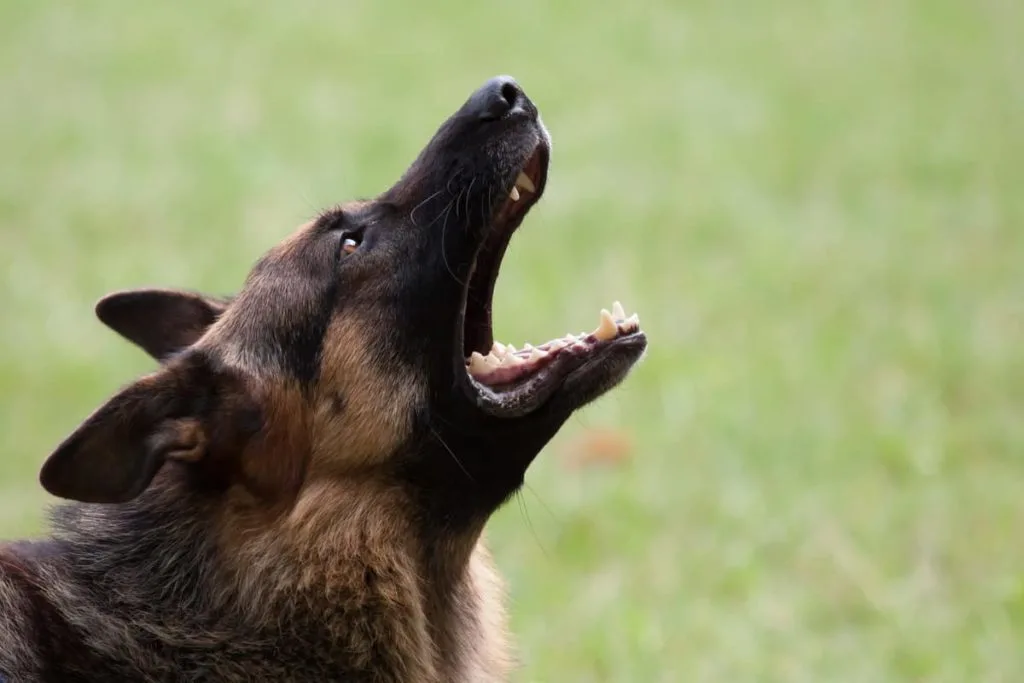
There are a number of reasons which may contribute to a German Shepherd being aggressive.
And we can all agree that an aggressive German Shepherd is not good for anyone, including the dog.
In this article, we will take a look at the causes of aggression in a German Shepherd, as well as how you can do your best to avoid or prevent it.
But first, it’s important that we define what aggression is and what it is not.
Click Here to Jump to a Section
Distinction Between Aggression and Dominance
I have personally heard many people pass off their GSDs aggression as the dog being dominant. This is simply not true.
It is unfortunate that people do not know any better than to explain their dog’s aggressive behavior in this way, because what that unintentionally does is create an excuse for the dog to continue behaving in this manner, while also giving the owner an excuse to continue allowing the behavior.
How Does a Dominant German Shepherd Behave?
A dominant GSD essentially likes to be the center of attention and will do what it needs to do in order to establish that.
It is not acting in a way that is coming from a fear of some sort, instead it acts in a way that is an attempt to prove to the world that it is the leader and needs to be taken seriously.
Some behaviors of a dominant dog:
- One-upmanship: He will go to great lengths to show he’s the fasted kid in class. He’ll outdo other dogs when playing fetch and he will move another dog aside for your attention.
- Shows his strength: He will never give up on a game of tug of war, be it with you or another dog. He will show that he is stronger than the next dog or person each and every opportunity that arises.
- Stare downs: He is all about eye contact, but not as a sign of affection. His intent is to show you that he will not budge and that you should seriously consider submitting to him. He will do this with both people and other dogs.
- Mounting: He will, bluntly put, mount anything that he can. He will not discern between male and female, as this is not an attempt to mate, but more a showing that he is in control.
- Stealing food and toys: He may steal toys and food from other dogs just because he can and to show that he’s in charge.
One of my dogs used to just take bones away from my Rottweiller and go sit with them on his own bed. He didn’t chew them, he just took them. That was the point he was trying to make – “I can and I will.”
How Does an Aggressive German Shepherd Behave?
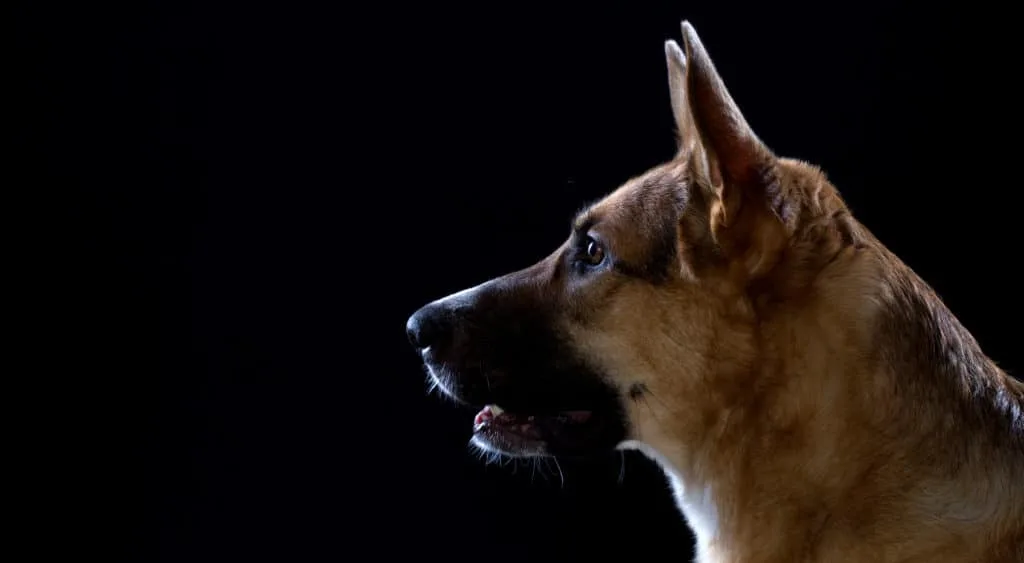
An aggressive GSD is coming from an entirely different place psychologically than a dominant one. While dominant behavior is exhibited by a dog to show everyone who’s boss, the root of almost all aggression is fear.
So when a GSD displays aggressive behavior, it is not trying to show that he’s the boss, although it may appear that way.
Instead, there is either a primal instinct or learned fear from a past experience that is traumatizing the dog and causing it to lash out with aggression.
Types of aggression
- Possessive: At one time, dogs had to protect their food supply and sleeping dens from other predators. This primal behavior sometimes takes root in the modern dog and it becomes protective of its food and bones, lashing out at anyone who gets near.
You’ve likely encountered one of these dogs – all is well until you near their food or bone. You may not even know that you are close, but they are the first to let you know.
My first GSD was aggressive/protective of his food. So for my second GSD I made it a point as a puppy to get him used to my hand in his food bowl when he was eating and I would hold onto bones while he chewed them.
This resulted in him simply not minding at all. In fact, as he got older, he would bring bones over for me to hold for him so that he could get a better chewing angle. - Fearful aggression: This generally occurs when a dog feels that it has to defend itself, but it has nowhere to go. If given a choice, most dogs that exhibit this type of aggression will retreat and remove themselves from the situation. But if they are backed into a corner, they may feel that aggression is their only recourse.
- Defensive aggression: This is very similar to fearful aggression. It still arises out of fear, except the difference is that the defensively aggressive dog will not use retreat as its first option. Instead of letting itself get backed into a corner, it would rather handle the situation before it gets to that point.
- Aggression due to pain: This can cause a normally gentle and calm dog to become aggressive in an instant and with no warning. This is may happen if the dog has an underlying medical condition, or if it perceives something as likely to be painful.
This is one reason that dogs often lash out at veterinarians. The dog is not really thinking, it is just reacting. - Territorial aggression: This type of aggression simply comes from a dog’s primal instinct to protect territory that they view as their own. This is most likely the house they live in and/or the property that surrounds it.
A territorial aggressive dog may simply bark at unfamiliar people attempting to enter the home or property, but sometimes they will not just bark but will also bite – regardless of who the person is. - Predatory aggression: This type of aggression is closely related to a dog’s prey drive. Many dogs will instinctually chase something that it thinks is getting away.
This can be a kid on a skateboard or bike, a car, a jogger, or any number of other things just moving by. - Protective aggression: This behavior is sometimes displayed by dogs, especially German Shepherds, when they feel that part of their family is being threatened.
It is this type of aggression that often leads mothers to be protective of their litters as well as any dog being protective over a new baby in the family. - Frustrated aggression: A dog may display this when held back from something that it wants. For example, if a dog is excited and wants to interact with another person or animal and you try to restrain it, some dogs may become aggressive out of frustration.
Why Do German Shepherds Become Aggressive in the First Place?
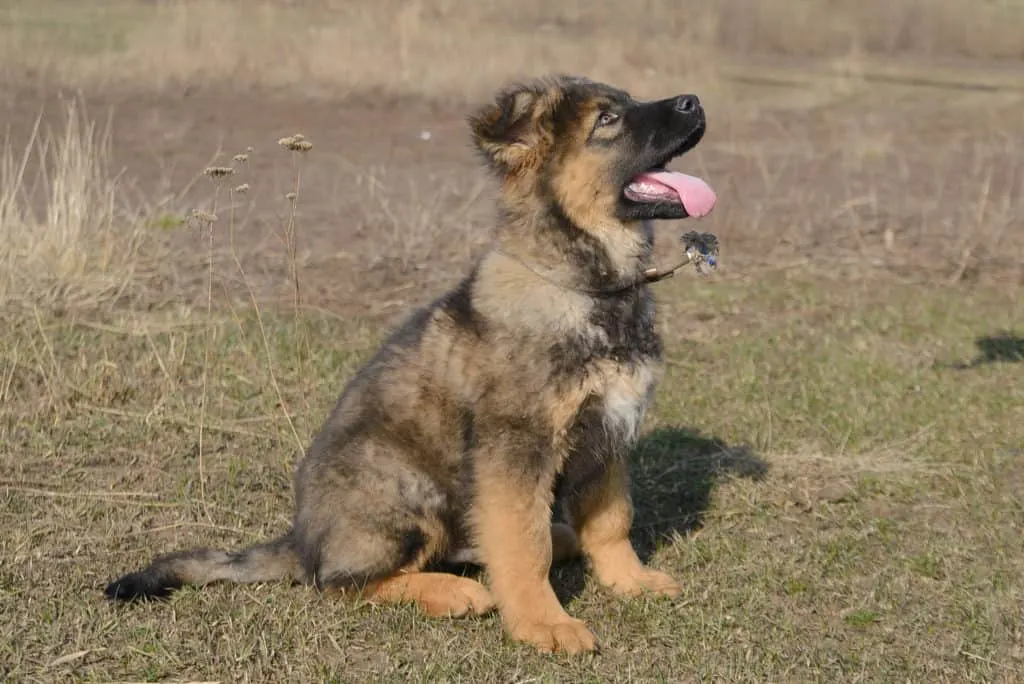
The potential for a German Shepherd to become aggressive begins at a young age. It actually begins when they are just several weeks old and under the care of their mother.
It is the mother’s job to socialize and encourage her puppies to behave well and interact productively with one another.
This job is not an easy one. Consider a human mother being overwhelmed with a child – the mother of a litter of puppies is in the same circumstance.
Just like people, first-time moms can have it rough. A GSD who is a first-time mom may just be overwhelmed. This stressful situation is also one which causes a lot of fear in the mother.
And when frightened, a German Shepherd mom might not act rationally – she may even act aggressively towards her puppies.
If a mother acts aggressively towards her puppies, then the puppies will no doubt also become frightened.
It is at this point that her puppies, because of their fear, may also begin to become prone to aggression. This will also make them more difficult to train as they get older.
One lesson here is that you need to make sure that your breeder is using the proper dogs for having puppies.
It is vital that understand the mother of the litter’s temperament to make sure that you are not getting a dog that comes from a frightened and ill-tempered mother.
If you plan on getting a puppy, make sure that you discuss this point in-depth with your breeder.
How to Prevent Aggression Through Proper Training and Socialization
Making sure that your GSD does not develop into an aggressive dog is largely up to you. The actions that you take when your GSD is a puppy and growing up as a young adult are key to preventing aggression.
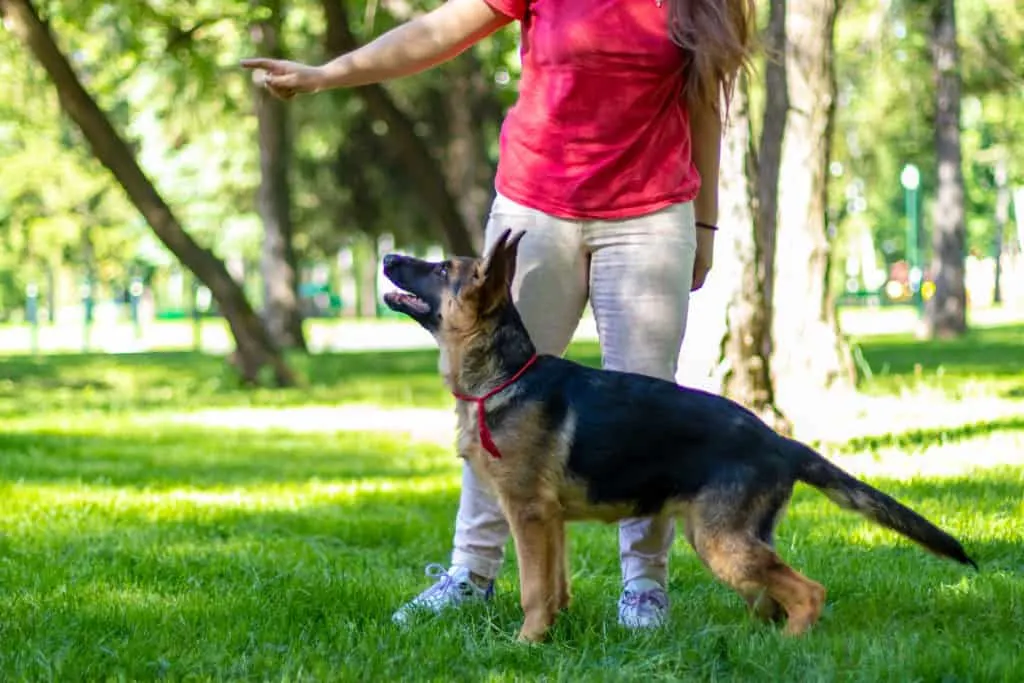
Consistency in Training
As your puppy is growing up, it will be exposed to all manner of different things that are brand new to it.
There will be new people, new places, objects, new animals, and just new experiences all around.
While your puppy is going through all these changes, there needs to be a constant. And that constant is you.
More specifically, the constant is you and the discipline that you give to your puppy.
Disciplining here does not mean correcting your dog every time it does something wrong.
Rather it means positively reinforcing your GSD every time that it does something correctly.
And the best way to make sure that your dog is doing something correctly is to associate a reward with something that it wants.
The first step to accomplish this is by requiring your dog to perform an action any time that it wants something.
If your puppy approaches you and wants anything at all, make sure that there’s an action associated with the puppy receiving what it wants.
Examples
- Your puppy is approaching you and whining to go outside. Your first instinct may just be to take the puppy outside.
Do not do take the puppy outside before making it sit.
As your puppy gets a little bit older and accustomed to doing this one simple action, you will need to increase what you require of your puppy.
Just as a teenager needs responsibilities to grow, so does your puppy if you want to keep it disciplined and away from aggressive behavior.
- Your puppy is wanting a treat.
Before the puppy is allowed to have a treat, make it lie down and roll over first.
- Your puppy is coming to you and asking for a walk.
Have the puppy go over and sit, lie down, and stay by the door.
- Your puppy is coming to you and wants to play.
Have the puppy shake and roll over, then shake again, and then sit.
Use your imagination with all of this, your GSD puppy is very smart. You may even find that your puppy begins to approach you after doing these behaviors for some time and just does them on its own.
This can be a bit tricky, but it’s important here that you don’t give in. If it’s not time for a treat, or play, or a walk, then it will do the behavior and receive no reward.
This is ok – praise your puppy for asking politely. This is a good way to teach it that it cannot always get everything that it wants whenever it wants it.
While it may be very tempting to give your puppy a treat or a toy simply because it’s your puppy and you love your puppy. But going down this route will be setting you up for failure.
Just like a teenager, if you give them too much and they have to do nothing to earn it, they may begin to feel entitled, and reluctant to work for anything in life. Your puppy really is no different.
What If My Puppy Gets Upset and Starts Barking or Biting When I Don’t Give It What It Wants?
Depending on the puppy, if you deny it what it wants, some may sulk, some may accept it, and some may express their frustration by growling or even biting.
This behavior is simply not acceptable, and it’s potentially dangerous, so you must at this point take great care to discipline your puppy in the correct manner.
If this occurs, your number one priority is to keep cool. Do not express any negative emotion or raise your voice. Keep cool and stay quiet.
Do not respond to your dog’s aggression.
And under no circumstances should you get physical with your dog. Do not try to restrain it, and certainly never smack or hit it.
If your dog barks at you or even nips at you, it’s very important that you do not react back to your dog in a physical manner.
Many many people often make this mistake. They feel that by grabbing onto their dog or physically overpowering it they are showing it who’s boss.
This could not be further from the truth.
When a German Shepherd shows aggression towards someone and is met with aggression back, the dog views it as a challenge – and a German Shepherd will not back down from a challenge. It’s not in their nature.
If you react to your dog’s aggression physically, you are also teaching your dog that it’s ok to act this way.
Your dog is simply trying to get your attention. He already tried sitting and doing a trick or two and that didn’t work. So now this is another attempt and nothing more. Do not read into it beyond that.
And if you meet your dog getting physical with you getting physical, you are simply showing it that it has now found a way to get your attention when all else has failed.
It will think, “well that didn’t work and that didn’t work, but this worked. Maybe I should do that next time.”
Because of your reaction, in the future, when your dog wants something he may not even try to get your attention in any other way because you have proven to it that getting aggressive works quite well.
This is a crucial point in correcting your dog’s behavior for good. If you do not approach this situation in the proper manner, you will be setting a terrible example for your dog, and creating a pattern that you may never be able to train out of it.
So be smart about it, you can keep your cool. And you must.
Just remember that it’s not your dog’s fault and it’s not acting out of malice towards you, it’s simply a means to an end.
Corrective Action
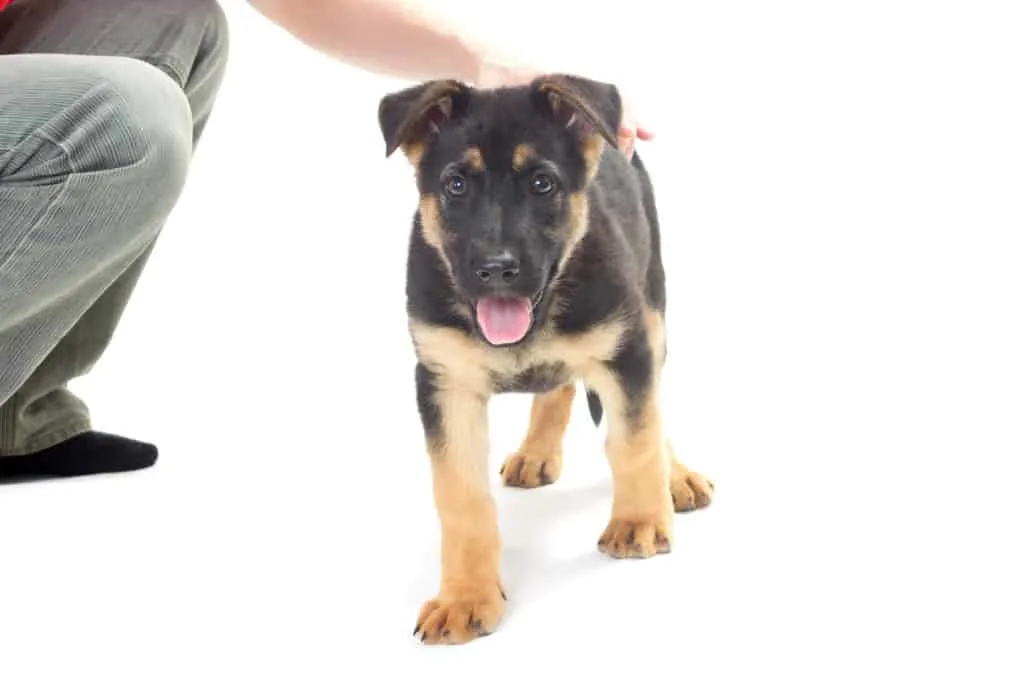
Now that you understand the importance of not raising your voice at your dog and staying calm, you can move on to properly correct your dog’s behavior.
Follow these steps:
- Remain unresponsive and nonreactive. Do not raise your voice or say anything at all to your dog.
- After a few moments of silence, either hold onto your dog’s collar or put it on a leash and lead it to another room, away from the scene of aggression.
- Once you are in another room, calmly speak to your dog and command it to sit and lie down.
- Stay in this place with your dog until it calms down. It may whine at first or even bark. But just stay the course until your dog is calm.
- Let bygones be bygones. It’s over, end of story. Do not hold a grudge. Your dog loves you and has limitless forgiveness toward you – you should have the same attitude.
Take a moment to understand that each and every time that you don’t react to your dog’s aggression, and instead you correct it in a calm and methodical manner, each of these instances is analogous to placing a brick on a wall that you are building.
If you lay each brick carefully, you will have a solid wall. But if you fail to lay a brick, or lay it improperly, you will have an unreliable wall that will not stand the test of time.
Understand that this will take time, repetition, and consistency on your part. Just be patient and build your wall properly.
And know that if you do it properly, the odds are very much in your favor that this type of aggressive behavior will be trained out of your dog.
If you fail to do this properly however, you may be opening a door that down the line could lead your dog biting someone or even worse.
Socialization Is Key
This topic is addressed a number of times on this site because it is so important.
So before we even begin on this topic, be sure to take a look at or bookmark the article linked below:
How To Socialize Your German Shepherd
A German Shepherd that is not properly socialized may grow up to be timid, it may have anxiety problems, it may be depressed, or the worst-case scenario is that it may become aggressive.
One of the reasons that you likely got your German Shepherd is because you love the idea that it is naturally protective of you.
Related: Will My German Shepherd Protect Me Without Training?
Your German Shepherd does not need any specialized attack or protection training for this to happen, it comes instinctually to a German Shepherd.
However, unless you socialize your German Shepherd properly when it’s a puppy, your dog can develop a fear of new situations.
And a fearful dog that is powerful, and knows that it’s powerful (just as a German Shepherd does), can quickly become aggressive.
Your German Shepherd was bred to be protective, and they are territorial by nature, so it is its instinct to protect you and your home.
As far as the dog knows it’s doing its duty. It’s simply protecting itself or protecting you out of fear that something is going to happen to you.
When confronted with a new situation, your dog will use its best judgment in determining how to react.
But without having the proper foundation for making good decisions, such as a variety of past experiences that you created for your dog, there is no telling how it may react.
Because its instinct is to protect you, if it misjudges a situation as one that warrants being fearful, it may well act aggressively in an effort to protect you.
Socialization Overview
People
When a German Shepherd is meeting a new person for the first time, it may not know what to think, and on an instinctual level, it is gauging whether the person is friend or foe.
So when introducing your GSD to a new person, your behavior is key, as well as the behavior of the other person. The person needs to be aware of the purpose of your meeting.
The person must clearly understand:
- The purpose of them meeting your dog (socializing it).
- To remain calm and act only in a positive manner.
- To not make any sudden movements, especially towards you.
- If you are near your home, then not to make any sudden movements towards your property.
It’s important that you and the other person adhere to these points. I will give you an example from my personal experience when the other person did not do as instructed, and they got nipped.
Keep in mind, however, that the following account was with one of my dogs when he was around 1 year old and was being trained to protect our home. Therefore, his natural protective instincts were heightened. It nonetheless serves as a good example of what can go wrong if an introduction is not made properly.
I began by introducing a friend of mine to my dog off of our property.
They got along well, so we then progressed to the point where I would hand the leash over to my friend and he would walk the dog himself, again off of the property.
Then we gradually brought my friend into the yard. Me, my friend, and my dog would sit and the yard and talk while my friend petted my dog.
But I advised my friend never to make the first move towards the house and to always let me lead the way.
My friend got a little bit too confident because the dog and him and were interacting very well.
And because of his overconfidence, he just became absent-minded and decided to make a move towards the house.
That’s all it took, a movement towards the house was met with a firm nip in the chest.
And for the dog, there was no grudge, no further aggression – no nothing. The situation was over for the dog. To him, he was just clearly defining his boundaries.
I had done the same thing multiple times with different people who all followed my direction, and my dog grew to love each one of them.
Had my friend in the above instance carefully listened to and followed my instructions, there would have been no problem.
He would have been able to come into the house in a matter of minutes and there would have been no issues with the dog at all.
The point in relating this story is to make sure that whoever you are socializing your dog with is prepared, and to ensure that all introductions go smoothly.
You should introduce your German Shepherd to new people frequently and in different settings.
Make one introduction near your home. Make another introduction in your home. Do another while out shopping. Do another inside of your car.
Any circumstance that you may ever potentially be in with your dog and another person needs to be covered during this time in his life.
Proper socialization also includes your dog being introduced to all different kinds of people. Introduce your GSD to:
- tall people
- short people
- younger people
- older people
- skinny people
- heavier people
- people of different color and ethnicity
- babies
- children
- handicapped people
- loud people
- quiet people
- people in shorts
- people in pants
- mobility restricted people
My last GSD was was pretty good with most people, and this led me to believe that he was well socialized, but he had never had to opportunity to interact with a person in a wheelchair with a service dog before.
And the first time that he did see a person in a wheelchair with a service dog, his reaction was tremendous. He began pulling towards them and barking very aggressively.
I immediately acted to correct the situation, and to my relief, the person was actually thankful. This is because the person in the wheelchair and the working dog were together with a group that was actually in training.
But this example is without question the exception and not the rule. You ideally never want your dog to react in this manner.
I learned from that point on exactly how important it is to introduce my German Shepherd to every conceivable type of person that I’m able to.
You won’t find any difficulty in finding new people to introduce your puppy to. I personally have never come across an individual who isn’t delighted to meet a puppy.
But just make sure again that the person understands that this is all new to the puppy and that they should interact with the puppy only in the ways that you instruct them.
Because if a person gets too rough or does anything to scare the puppy, it will have the opposite effect of what you are trying to accomplish.
It may make your puppy fearful and prone to aggression if it experiences a person in the future doing the same thing.
Animals
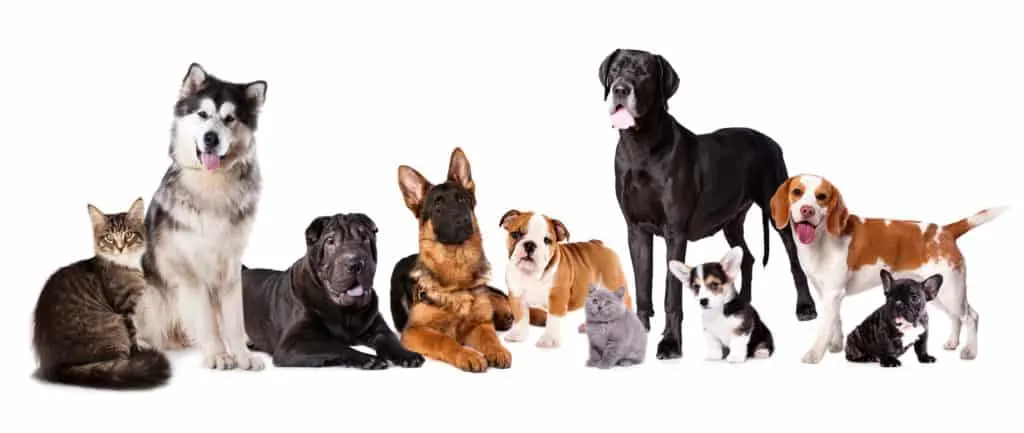
It’s not just people that you need to get your German Shepherd used to meeting in order for it to be properly socialized.
Meeting other animals is also vital to proper socialization of your GSD.
During the course of its life, your dog will run across countless other dogs. This may happen while out for a walk or at a park.
Or if you live in an apartment building, your dog will be crossing paths with many other dogs in close quarters
Your dog will also come across cats wandering around, along with all types of other animals. Squirrels, birds, cows, it all depends on where you live and your lifestyle.
But it is crucial that your dog has at least laid eyes on these things and is shown that they do not present a threat and that they are not things to be aggressive towards.
So to ensure that your dog reacts properly, and even in a friendly manner when it comes to new animals, you must make sure that it is ready for them.
A properly socialized German Shepherd will get along with almost anything. It will react aggressively to other animals only if those animals are presenting a threat to it, and not the other way around.
Places
Take your puppy everywhere. By everywhere I mean anywhere you go, when possible, take your puppy too. Within the first year of my last GSD’s life:
- He had gone swimming in a pool, in a lake, and in the ocean. He swam alone, and he also swam with as many as 8 other dogs and their owners at the same time.
- He hiked through the woods alone with me, as well as with a group of people.
- He came to outdoor shopping malls with me, where he interacted with many different people and many different dogs.
- He met all of my neighbors and their children. They gave him treats and they also threw a ball for him.
Your mindset should be that the puppy needs to experience something new as much as it’s within your capability to provide that. Just ask yourself, “is this different for my puppy?”
And really look at the small things. Your puppy may run and play on the grass or walk down your driveway or sidewalk, or it may take a walk on the beach.
But your puppy doesn’t wear shoes, and these different surfaces are very new and noticeable to it.
So make sure that your puppy experiences as many different surfaces as possible. As simple as something like this may sound it can make a big difference to your puppy.
And when making occasional home repairs, make sure that you do these around your puppy. If a puppy is not used to it, a hammer can be a scary sound.
So can a drill, and so can a vacuum cleaner. The same goes for a washing machine or a garbage disposal in a kitchen sink.
Garbage day can be a treat for a lot of dogs. They stare out the window wondering what it’s all about, they see the big truck and the workers – but to an unsocialized dog, this could seem very threatening.
Your dog has no idea what these people are doing except showing up on its territory and making lots of noise. So make it a point to take your dog outside on garbage day and actually have it interact with the workers.
People on skateboards and bicycles are also important for your puppy to get used to. Skateboards make a distinct sound that dogs notice, and a bicycle is just some odd thing carrying a person away.
I can recall a time when I was sitting outside with my puppy and he suddenly began whimpering and climbing on me for no apparent reason. But as I investigated, I discovered that his fear was of a motorcycle in the distance. A sound that I was used to and did not even notice.
So understand that a puppy does not know the purpose of most things, they are just new and potentially frightening.
So it’s very important to get them used to all things possible from a very young age to avoid aggression towards new things as it gets older.
Managing an Aggressive German Shepherd
As we’ve discussed, a number of factors can incite a dog to be aggressive.
Much of it has to do with the environment that the dog was raised in as a puppy and how well socialized it was.
But there are so many factors that come into play, that its often difficult to point to a specific one.
With training, aggression can be lessened or eliminated. And with proper socialization, it can be avoided altogether.
However, sometimes a dog is just too old or poorly bred to be trained out of its aggressive patterns. If this is the case, you will always have to be on your guard.
The best thing you can do in this scenario is to get to know your dog well.
It is possible to manage an aggressive dog. If there are situations where you feel that you know the dog will become aggressive, like around a certain type of person, or in a certain circumstance, then you just need to avoid those situations.
Talk with Your Veterinarian
If you have tried everything within your own power to manage your dog’s aggression and it has not worked, don’t give up yet. Your vet may be able to help you isolate the issue.
As we’ve covered, it could be due to an underlying medical condition, or it could be some other issue related to old age like joint pain.
Work with an Animal Behavior Therapist
For people that may have complex psychological issues, a therapist can help to unravel the ball of yarn, so to speak. The same applies with your dog.
You may be surprised at what a professional dog behavior expert may be able to accomplish with your dog and you together.
So if you feel that your dog is aggressive, take a step back and do not get frustrated. Go through the proper channels, speak with your veterinarian, and speak with a behaviorist.
Chances are there will be a hopeful future.
